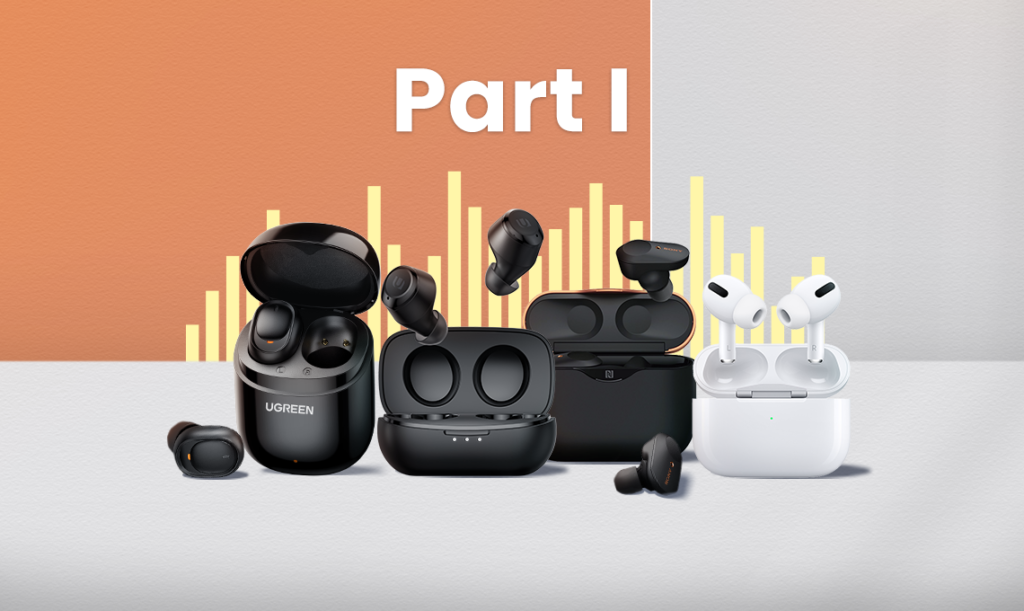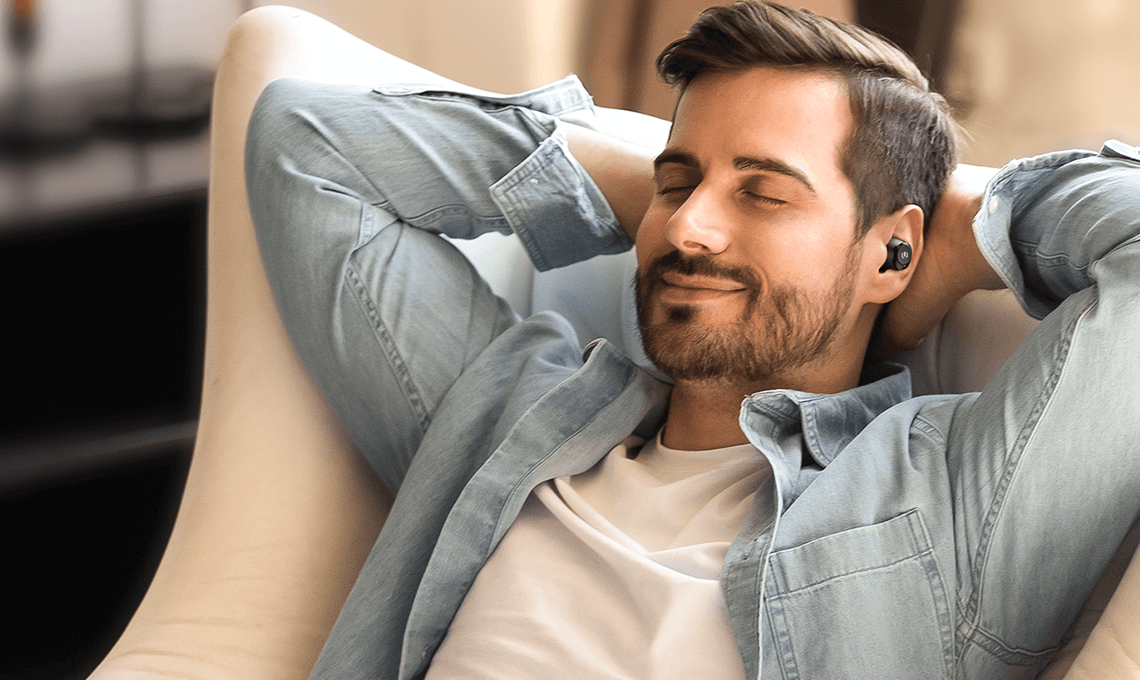The True Wireless Stereo (TWS) headphone market is booming. Every month we’re seeing a new product launch, and the technology is one of the most rapidly evolving in the field of consumer acoustics. But what is driving all this action? Are TWS Earbuds really that much better than traditional, wired devices? And what are some of the best TWS devices on the market today?
What is True Wireless Stereo (TWS) Technology?

True Wireless Stereo technology is all about enjoying real stereo sound without the hassle that comes with cables. Stereo sound means that the left and right headphones each receive their own channel, which allows for a crisp, immersive listening experience compared to mono (single channel) sound. Pseudo-wireless headphones, with a short cable between the left and right headphones, have been around for a while. It’s only more recently that truly wireless headphones have hit the scene.
Specs to Look out for
Not all TWS devices are created equal. There can be critical differences in specifications that lead to very different listening experiences. If you’re in the market for TWS Earbuds, you should look out for the following…
Bluetooth tech
Bluetooth is a technology that allows devices to communicate wirelessly. All modern wireless headphones depend upon Bluetooth to be able to receive music from a phone or other device. Bluetooth has undergone many iterations over the years. The latest version, Bluetooth 5.2, offers some notable changes that are great if you’re considering TWS Earbuds.

Bluetooth Low-Energy, also known as BLE, was part of the Bluetooth 4 upgrade. It does exactly what it says on the tin, namely allowing devices to talk to each other over the Bluetooth protocol whilst consuming significantly less energy than before. The advent of Bluetooth 5 came with Bluetooth Dual Audio. With this feature, you can connect two different audio devices, such as a car sound system and your Bluetooth headphones, to your phone simultaneously.
Chipset
The chipset is another name for the Bluetooth transmitter/receiver inside your headphones. The chipset is what enables TWS Earbuds to communicate wirelessly with your phone.

Major brands that provide system-on-chip (soC) solutions for wireless headphones are Qualcomm, Realtek, AppoTech, Actions, BES, and Cypress.
More recently, Huawei and Apple have begun to use their own proprietary SoCs in their headphones. This move will allow the two companies a greater deal of control in deciding what features to include in their audio devices, as well as (hopefully) lowering the overall cost to the consumer.
Drivers
Headphones have plenty of different elements, but arguably the most important is the driver. The job of these tiny units is to convert electrical signals into sound and then drive it down through your ear canal. Without drivers, you’d be walking around with ear plugs rather than headphones.

Drivers are generally made up of three components:
- A magnet, which creates a magnetic field
- Voice coils, which move the diaphragm and create sound when an electric current passes through them
- A diaphragm, which vibrates to create sound waves
Earphone drivers are usually 5mm – 15mm in diameter. But that’s mainly because headphones are built around the driver and in-ear models have to fit into a certain size bracket. But driver size is important to a degree. Larger diaphragms are capable of pushing and pulling more air compared to smaller ones. That means a greater variation in sound pressure, stronger sound waves, and louder volume – especially when you’re in the mood for heavy bass.
There are four different driver types you need to consider when choosing a pair of headphones, Dynamic Drivers, Planar Magnetic Drivers, Balanced Armature Drivers, and Electrostatic Drivers.
- Dynamic Drivers
First up are dynamic drivers. These usually feature a larger diaphragm and provide a more bassy punch as a result. These are the most common found in headphones, in part because they are affordable for manufacturers and do a decent job without using up too much power.
- Planar Magnetic Drivers
Planar Magnetic Drivers are usually found in high-end earphones and headphones. The diaphragm is sandwiched between magnets. The result is a clean sound with little distortion.
All that accuracy comes at a price though: Planar Magnetic Drivers usually require external power.
- Balanced Armature Drivers
Balanced Armature Drivers are the smallest type of driver around and are most commonly found in in-ear headphones. Manufacturers tend to have several in a single earpiece, which allows the earphones to reproduce a range of frequencies with minimal distortion.
- Electrostatic Drivers
Electrostatic Drivers rely on diaphragms that are electrostatically charged. As a result, there are no moving parts, negligible distortion, and overall exceptional sound quality. You’ll most commonly find these big, expensive headphones in professional studio environments or the homes of your audiophile friends!
Audio codecs and encoding methods
A codec is a piece of software that compresses data in order to transmit it, and then decodes the received data. The codec that your Bluetooth headphones use can have a major impact on the quality of the sound you hear on playback.
Despite their importance, Bluetooth codecs are one of the most often overlooked aspects of TWS Earbuds.
TWS Bluetooth Codecs
- SBC
SBC was the very first codec used in Bluetooth devices, but it now has a reputation as being one of the worst around. The main problem with SBC is the effect of compound compression. Audio transmitted via SBC will have already been compressed, for example as an MP3, and then compressed again when transmitted over the air, causing a significant decline in audio quality.
- AAC
AAC has become the standard for transmission of audio across Bluetooth and is used in all Apple products. The plus side is that any audio encoded using AAC, regardless of the file format (MP3, MP4 etc), doesn’t have to be compressed to send it over the air.

- aptX, aptX LL, aptX HD
A relative newcomer, aptX and its variants have been entirely designed and developed by the mobile chipset manufacturer Qualcomm. aptX has a bitrate of 352kbps for 16-bit audio with a sampling rate of 48khz, whereas aptX HD offers a whopping 576kbps for 24-bit audio! This increased bandwidth enables greater preservation of data and higher audio quality.
- LHDC & LDAC
Low-latency and high-definition audio codec (LHDC) and Sony’s LDAC are two high-end codecs that offer maximum bitrates of 900kbps and 990kbps respectively.
Currently, LDAC has not been widely adopted by TWS manufacturers. But many TWS buds support LHDC.

You’re Halfway to Becoming a TWS Master
And breathe! So far we’ve covered all the technical details that go into building TWS earbuds, from codecs and audio drivers to chipsets and Bluetooth technology.
In Part II we’ll be diving into the operational functions of TWS earbuds and answer some of your frequently asked questions.
The aim of all of this is to help you understand TWS earbuds inside out. If you’re enjoying the ride so far, you can subscribe to receive more articles just like this one. And, as always, let us know in the comments below which TWS element is most important to you!














Hola
TenGo unos aiwa pero me gustaría. Probar estos además. Compre un Hub 3.0 y no viene. El conector ac , comonouedo solicitar uno soy de chile
Hi Carlos, please contact via the email [email protected]
Am really impressed by their Brand.
I just bought their Ugreen TWS earbuds 80636 yesterday. I bet you the sound on this hardware is amazing. Am looking forward to purchase more products from their line up.
Hello, thanks for your input, and we always try to offer our customers better products, thanks.
Seeking your cymbal. I bought 3 Bluetooth receivers version 3. The receiver works great I am very satisfied. I understood that there is version 5 Is there a difference in audio quality between the versions? Recommend to replace ??
May I know the brand/model type of your Bluetooth receiver? The receiver version doesn’t stand for bluetooth version. Currently the popular Bluetooth version on market is BT4.2 or BT5.0, and both are compatible for most Bluetooth devices. Therefore, if you didn’t encounter any connection issus, keep it the same 😉
I can’t get a response on a warranty claim.
Hi, please contact us via email [email protected], and we will solve the issue as soon as possible.